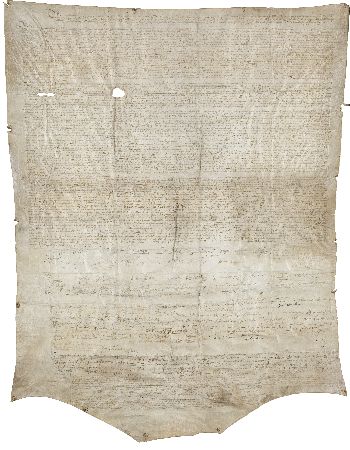National Covenant
£25,000
Auction: 10 June 2009 at 12:00 BST
Description
Document on vellum signed by over 100 Covenanters. Renfrewshire, 1638, c. 85.5 by 65cm [at furthest points], signatures include the Earls of Montrose, Cassillis, Eglinton, Wemyss, Rothes, Lindsay, Lothian, Lord Blamerino, et al, scalloped lower edge, vellum cockled, 15 pin holes around outer edge [some with rust marks from pins], three holes with text loss, the first 18cm from upper edge, hole 0.75 by 4cm, the second 16cm from upper edge, hole 2.5 by 4cm, the third 16.5cm from upper edge, hole 1 by 1cm, some text loss to lines 25-29, some small areas of fading to text [due to variations in ink used], 19th century ink inscription on verso reads "The solemn league and covenant, 1638, the original document 1638, [signed] W. Alexander"
Footnote
Provenance: Purchased from Maggs for £100 in 1950.
Note: The Scottish National Covenant of 1638 was the result of various attempts by the Stuart monarchy to unify religious worship throughout England and Scotland. James VI & I had made a few cautious attempts to introduce a measure of Anglicanism into Scottish life, however, it was his son, Charles I, that firmly believed the Kirk should be brought into line. In 1637 King Charles I and Archbishop Laud endeavoured to impose an English liturgy, a move that the Scots saw as little less than an attempt to reintroduce popery. The spontaneous objection during that first service soon developed into organised opposition unified around the text of the National Covenant.
The 1638 document developed from the National Covenant of 1580, which denounced the Pope and the doctrines of the Roman Catholic church. The newly formed Covenant incorporated the Scottish Confession of Faith of 1581 and the Acts of the Scottish Parliament that had established the Calvinist religion and the liberty of the Kirk.
The original document was neatly written and signed by a large gathering on February 28th 1638 in Greyfriar's Kirkyard, Edinburgh. The leading Covenanters - Rothes, Montrose, Eglinton, Cassillis, et al - then created duplicate copies to be dispatched "by the considerable persons themselves" into every shire, presbytery and parish of Scotland for signature. The copy on offer here is the Covenant of Renfrewshire.
The General Assemby of 1638 was composed of ardent Coventanters and in 1640 the Covenant was adopted by the Parliament and its subscription was required from all citizens. Over the next few years King Charles' s attempts to deter his subjects by force were unsuccessful, leading to the eventual recalling of the English Parliament - an act that would begin the chain of events that led to the English Civil War.

